Please Note: Firefox and some other search engines are not suitable
– Use “Internet Explorer” for this page to load perfectly!
Click the
logo above to reach the ssMaritime FrontPage for News Updates & “Ship
of the Month”
With Reuben Goossens
Maritime Historian
Peninsular and Oriental Steam Navigational Company - P&O
RMS Kaisar-i-Hind (2)
“Kaisar-i-Hind”
is a Hindi name meaning “Empress of
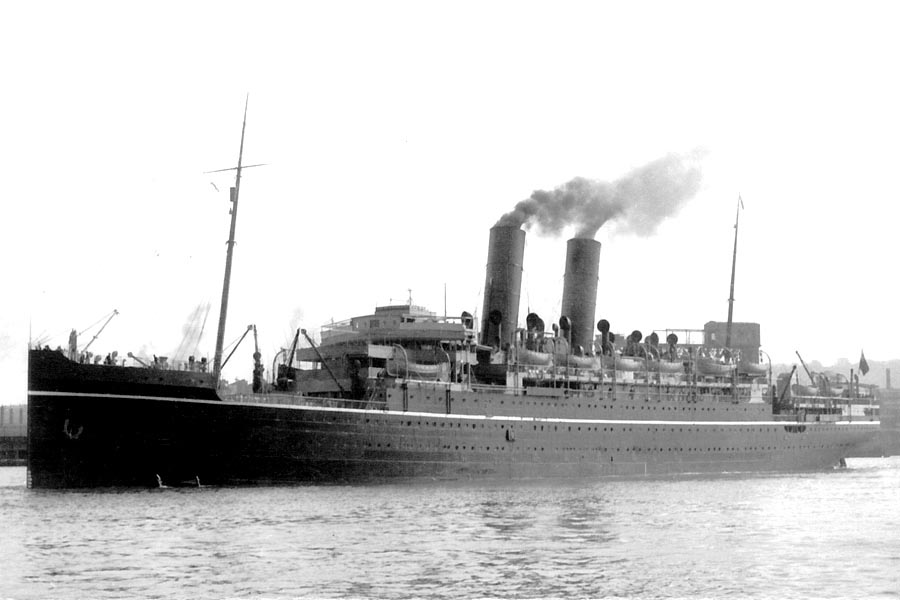
An excellent photograph of the RMS Kaisar-i-Hind around 1926
Photograph by by-A.
Page Two
--Soldiers, Passenger & Crew Stories--
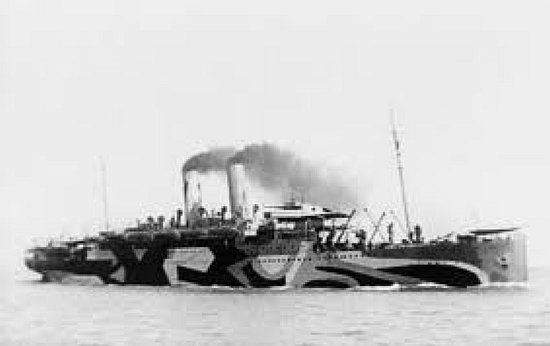
Here is a rare photo of the HMS Kaiser-I-Hind seen
in her special camouflage livery
Source of the photograph is unknown having been sent in by a supporter
*Please see the Photo notes at the bottom of the page
1 - Colonel Thomas Edward Lawrence:
One of her most notable passengers was
Col. T. E. Lawrence, who was more famously known as: “Lawrence of
Arabia” or “El Aurens”
by the Arabs, who after his lengthy “Revolt in the Dessert”
left Egypt to go home to England on October 15, 1918 as he boarded the HMS Kaisar-i-Hind in Port Said and
sailing to Taranto (a major naval base in Southern Italy. From there he
travelled by train via
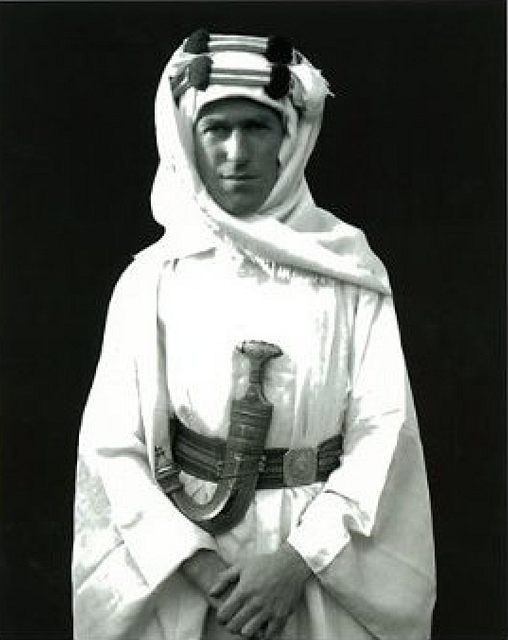
Thomas
Edward Lawrence of
Source of the photograph is unknown - *Please see Photo notes at the
bottom of the page
Later returned to his delightful small
home in Dorset named “Clouds Hill” from where he eventually hopped
onto his much loved “Brough Superior SS100” motorcycle to send a telegram and tragically Thomas Edward Lawrence was
severely injured on the way on May 13, 1935, which apparently had occurred in
the most suspicious circumstances. However, although in a coma,
His burial was held at the St Nicholas Church at Moreton and the service and was attended, as it would be a little later at St Pauls Cathedral special Memorial Service for Lawrence by Nobility, the famous and the great of the country including Sir Winston and Lady Churchill as Thomas Edward Lawrence was buried in the Churches cemetery.
Yet this great man sailed on the Kaiser-I-Hind having won his victory and as he became one of the most famous men in Britain, but somehow Lawrence’s fame rode with the Kaisar-i-Hind in many ways thereafter as many who where to sail to India desired to sail on the very ship that “El Aurens” / T.E. Lawrence had sailed on! PS: The author is obviously a specialist on T.E. Lawrence.
2 - Sergeant George F.
White:
Towards the end of December 2013 I
delighted to receive an email from a Mr. Jeffrey White, being the son of the
late soldier in question, who had obviously served in
“My father,
Staff Sergeant George F. White who was with the Hampshire Regiment and he
returned from
The photograph in question is the one further
down in this story entitled. “Sergeant’s Deck.” It was
interesting to discover that Act. Staff Sergeant George Frederick White was
a journalist with the “Southern Daily Echo.” However, in
September 1914 he volunteered and joined the 5th Battalion of the Hampshire
Regiment, along with members of the Hampshire County Cricket team. After a
short time guarding important installations in the Southampton and
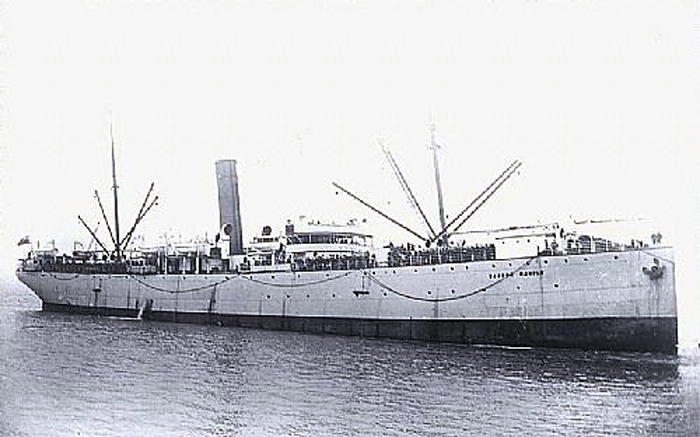
Built for the Union Castle Line, the HMS Cawdor
Castle – For interest,
on July 30, 1926 she ran ashore in
Photograph from the Author’s private collection
As the
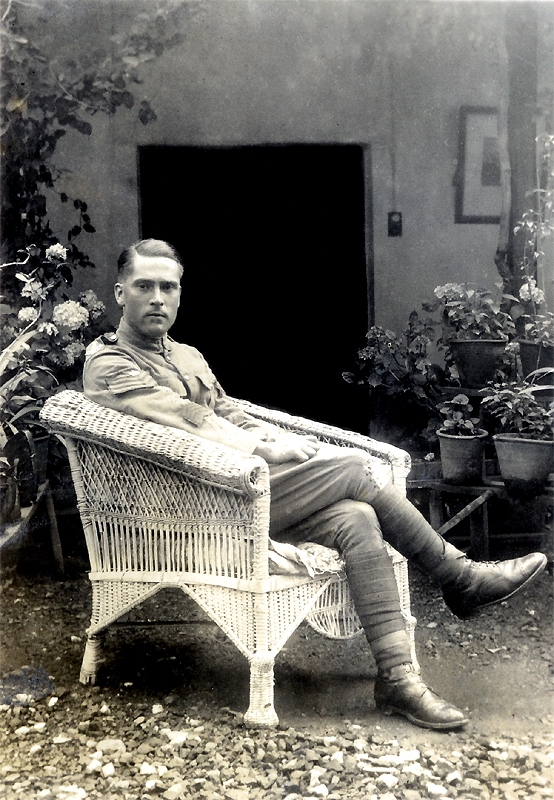
Here se see Staff Sergeant George Frederick White
Photograph restored by the author, but provided by the son Mr. Jeffrey
White
Three years later,
in 1917, George F. White was assigned to the Sir George Makins
Committee. Sir George Makins had been appointed
as the chair of a commission set up in that same year by the Government of
India. The commission was to report on the various British Station Hospitals
throughout
But finally the time came that it they were about to be homeward bound for it had certainly been a long five-year deployment in India, However, this time Staff Sergeant George F. White sailed home in a great deal more comfort on the voyage back than it was in 1914, for this time the ship was the excellent RMS Kaiser-I-Hind.
They departed
However, soon enough the ship was permitted to depart again and George White had a pleasant voyage with everyone enjoying shipboard life, including spending time out on deck, which for the Sergeants would be on their own especially reserved deck located just aft of the second funnel. We need to remember that in those days ranks simply did not mix! Thus with a ship laden a large number of happy men, all heading for home having been on service in India, they were all looking forward to arriving back home in the United Kingdom and rejoining their loved ones!
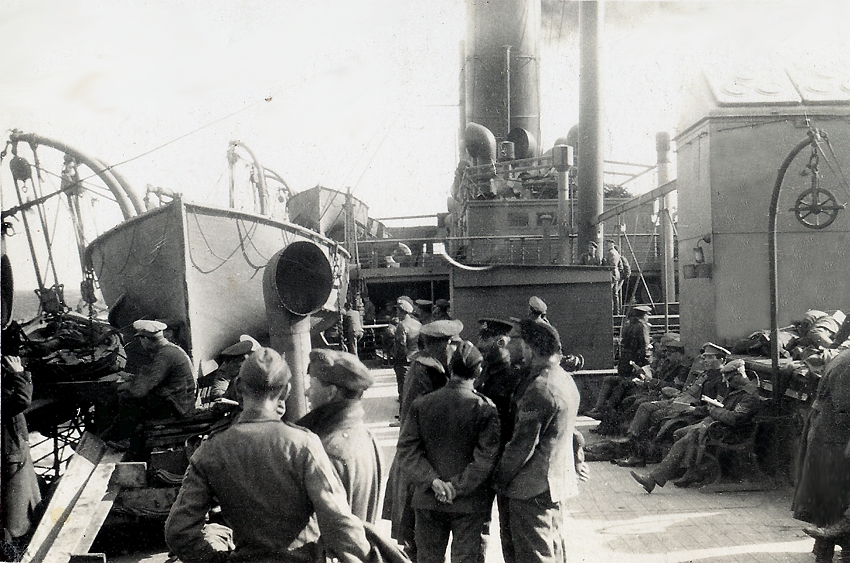
Here is a scene up on “Sergeant’s
Deck” aft of the Kaiser-I-Hind
Photograph restored by the author, but the original photograph taken by Stf Sgt George F. White
Provided by his son Mr. Jeffrey White
The Kaiser-I-Hind arrived in
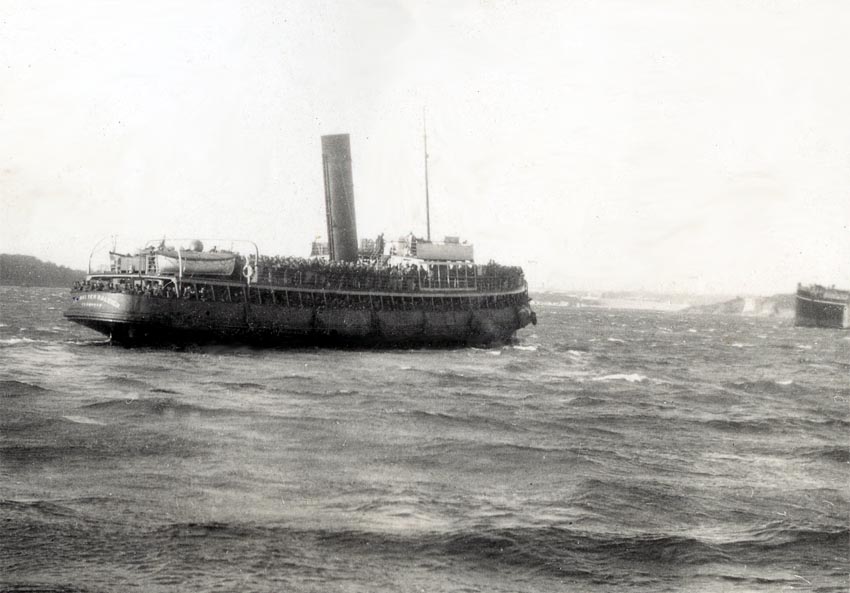
Sergeant George F. White titled this photograph:
“Landing at
Provided by his son Mr. Jeffrey White
SS Sir Water Raleigh:
For interest, I have decided to include a
little information of this fine tender. She was built by Cammell
Laird in 1908 and she was a well-known tender considering she had an unusually tall
slender slightly sloping funnel. She was to be used by GWR at both
From 1914 through to 1919 the SS Sir Walter
Raleigh was hired by the Admiralty both as a tug but also as a tender to
transport servicemen and others from ships anchored offshore at
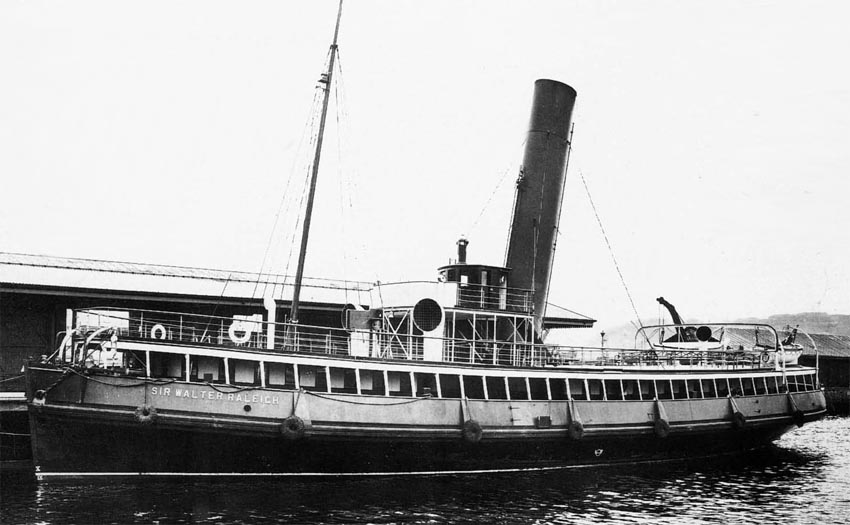
The brand new SS Sir Walter Raleigh seen berthed in 1908 at the Millbay wharves
Photo from the Author’s
private collection
In August 1939 the Sir Walter Raleigh was
again taken up by the Admiralty but this time she operated only from
In 1942 alterations were made to her
superstructure for her to be used as a mining tender. However, she returned to
GWR towards the end of 1945 but sadly the following year was sold and she was
used by a number of salvage operators, until she was sold to be broken up in
1968 after 60 years of excellent service! PS: For those who were on
another tender in
As George F. White settled back in into
his regular life he became best known in the
I wish to thank Mr. Jeffrey White the son of the late George F. White, reporter, serviceman and commentator! Jeffrey thank you for providing your Father’s most interesting story and his excellent photographs!
*******************************************
3 - Passenger
Hazel Rowe, nee Ditcham:
Here is a story from a passenger who sailed on
the RMS Kaisar-i-Hind in 1931. Hazel Rowe, nee Ditcham,
together with her Mother Irene (also known as Rene) embarked the Kaisar-i-Hind
towards the end of January 1931 to sail to
“My Mother was
rather sea-sick most of the time and she barely moved from her cabin, and I was
taken under the wing of another kindly passenger, a “very old” man
(about 35 years old – Ha!), who was named if I remember right Mr. Cropley or something very similar. He was presumably
also a civil servant, as my parents knew him and had met him several times
subsequently on voyages to & fro. I remember that I had been given as an
advance birthday present a rather splendid doll with a porcelain head, and
as many were in those days, it was a black doll. Unfortunately I managed
to drop it and the head smashed, whereupon the kind Mr. Cropley
took me to the ship’s shop and bought me another one, which was also
black, but it was a soft one this time. “Mrs. Sambo”
as she was called was my most treasured possession for many years, and later in
life my daughters were allowed to play with her, but then only on very special
occasions. As far as I know, Mrs. Sambo is still up
in our attic and has been for some years, but as we are planning to move house
in the near future she will have to come down, unless moth, dust or mice have
corrupted her past salvation. Thus she may be one of the only remaining
relics for me of that splendid old ship that took me to
I wish to thank Hazel Rowe for her interesting
story of her voyage on this amazing ship when so young, and considering that
she is now a spritely 85 years young, she is a wonder on the computer!
4 - Ships Fourth Officer Alfred Lee Harper:
“Father, Mr.
Alfred Lee Harper, was the 4th officer from March 1936 to March 1937 and I
still have his P&O ‘Second (Fourth) Officers’ P&O Sight
Book’ for that year.”
Harry also sent a photograph his father had taken which he had “entitled on the back “my Boats.” Below, I am happy to present 4th.Officer’s Harper’s Sight Book and his photo - these are all with thanks to Harry B. Harper.

Forth Officers Alfred
Lee Harper’s Sight Book
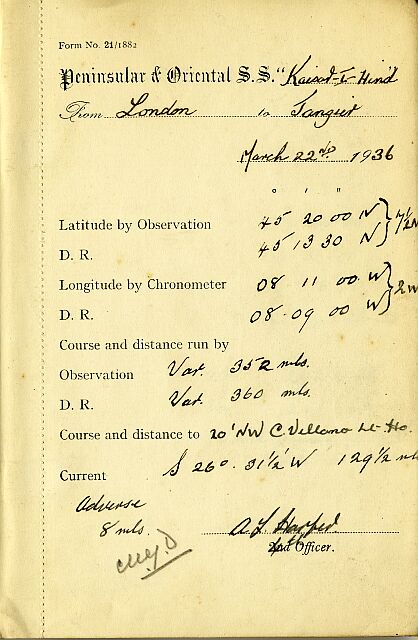
March 22, 1936 – report by Fourth Officer Harper
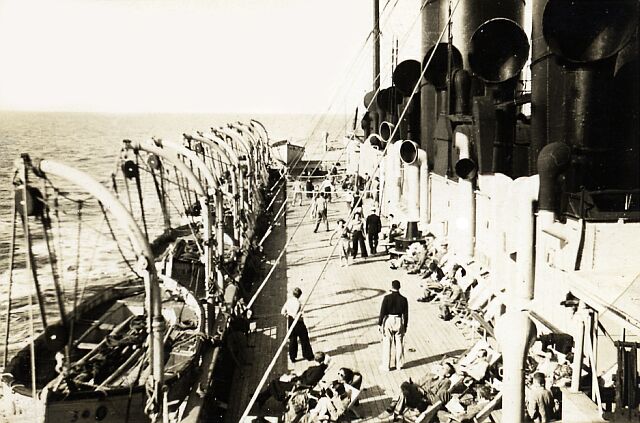
This is a photograph taken by 4th officer Alfred Lee Harper,
looking down to Boat Deck from the Bridge
***********************************
RMS Kaisar-i-Hind INDEX:
Page One: RMS
Kaisar-i-Hind history page.
Page
Two: Interesting
Servicemen, Passenger & Crew stories.
Page
Three
Use
the Back button on your browser or Close the Page to return to the previous
page
or go to our INDEX
***********************************
Who is the Author of ssMaritime?
Commenced
in the passenger Shipping Industry in May 1960
Also visit my …
“Save The Classic Liners Campaign”
This notice
covers all pages, although, and I have done my best to ensure that all
photographs are duly credited and that this notice is displaced on each page,
that is, when a page is updated!
ssMaritime is owned and © Copyright by
